 |
 |

Appropriately enough, I met my husband-to-be in Stanford’s library. He was finishing up the last year of his Engineering Ph.D., and I was – what else?! – researching my next book. Since our cultures are so different, many people wonder what it’s like to have an East-West marriage, and truthfully, it depends on the people involved. Before I met my husband, I had been a vegetarian for 17 years (many Hindus are vegetarian, and my husband is as well). We also have very, very similar beliefs – from religion to politics. If there is such a thing as a soul-mate (and I believe there is!) then I was truly fortunate to find mine – and in my thirties no less (so ladies, keep looking if you haven’t found him)!!
Should I add that one of his favorite places is a bookstore? Yup…. You guessed it. True love. 🙂 |
 Hello… Rosetta Stone?
Hello… Rosetta Stone? One of the greatest pleasures in the joining of two cultures is the chance to expand your knowledge, and with this in mind, I undertook the seriously challenging task of learning Hindi. I say challening because the grammar in Hindi is similar to the grammar Yoda uses when speaking, with verbs at the end. When I’m stuck, I just ask myself how Yoda would say it, and it all becomes clear (kidding!… kind of).I have no doubt I’ve mortified dozens of people along the way (and let me tell you, the process isn’t anywhere near over!). But it’s great fun, and my husband’s family is tremendously helpful, generous, and encouraging! Many people in India speak English, but there’s nothing like speaking the national language. |
|
|
|
|
|

On a riverboat safari in Kerala
For a country of over one billion people, it should come as little surprise that India is incredibly diverse, not just in its food, but in its religions, traditions, and landscapes. These vast disparities are what make India such a fascinating country not only to visit, but to write about.
In Jhansi, for example, where THE EMPRESS OF INDIA is set, the land is arid. The desert stretches out for miles on end, and water is a precious commodity. In Guwahati, however, where my husband attended IIT, it rains more than 60 inches a year. The nearby town of Cherrapunji sees the world’s heaviest rainfall, and although people normally think of India as dry, my husband’s university was surrounded by rainforest.
|

Our hotel in Agra, the Oberoi
When many people think of India, they think of all-encompassing poverty, and this is something that the media does nothing to contradict. While 32.7% people there live below the poverty line (as of 2011), there is great, great wealth in the country as well. There are hotels all across India which would give even the most lavish hotels in the US a good run for their money, and in the cities you’ll find the same luxury items as you would in any city in America.
But India’s real wealth isn’t in her banks – it’s in her people’s generosity and their incredibly rich history.
|
|
|
|
 |
As the world’s oldest practiced religion, Hinduism’s traditions and beliefs date back more than 7000 years to the late Neolithic period. Hinduism is often described as a way of life, rather than a religion, and for this reason, Hindus do not seek to convert. A few beliefs common to Hindus are:
- There is one God, and it doesn’t matter what you call him/her, or even which form he/she takes. In fact, in Hinduism, God takes many forms to remind people of God’s many powers.
- Murti (statues) are colorful representations of God. Hindus do not believe these statues are actually gods themselves, but different images of the one God which can help people focus on the divine.
- We all reincarnate, meaning we have more than one life.
- There is such a thing as karma. Therefore, bad deeds will come back to haunt you, and good deeds will reap future happiness and success.
Hindus’ most revered texts are the Vedas, written in Sanskrit more than three thousand years ago.
|
Few people realize that English is actually related to the Sanskrit language, and that within the Vedas are profound mathematical calculations, as well as shortcuts on how to do them (in fact, students in India today still learn Vedic math).
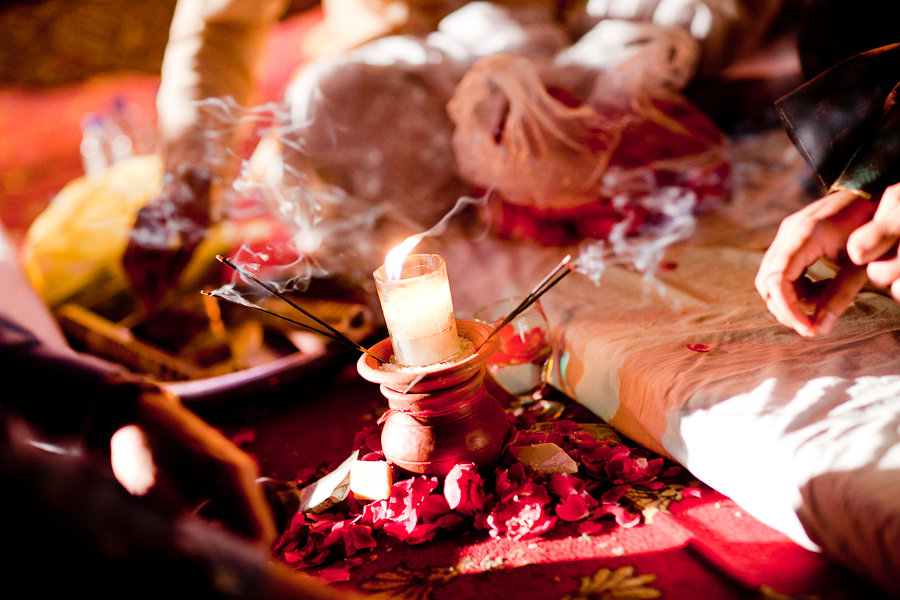
The word “Veda” means knowledge, and within these ancient scriptures readers find not just math, but philosophy, hymns, and the concepts of both 0 and infinity (which didn’t exist in the Western world during the time they were written).
|
|
|
 |
|
|
Both before and after the wedding, we arranged for our guests to tour some of India’s most famous and beautiful sites. We visited Delhi and Agra, and a few of the guests stayed on to visit Rishikesh and Haridwar as well. When everyone left, my husband and I journeyed south to Kerala, one of the most beautiful states in southern India.
|
|
|
|

Inside the Red Fort, Delhi. |

Qutub Minar, in Delhi. |
|
|
|

Standing in front of a statue of Hanuman, the monkey-headed god of loyalty.
|
 Houseboating on the canals of Kerala, which Marco Polo called the “Venice of India”. Houseboating on the canals of Kerala, which Marco Polo called the “Venice of India”.
|
|
|
|

For my arrival in Kanpur, my in-laws arranged a surprise flower-shower welcome! |
|
|
|
|

Ready. Aim. FIRE! In Hindi, a cannon is called a Tope, the same name (coincidentally), as one of the major characters in my sixth book, set in India. |

The three largest festivals in India are Diwali, Deshera, and Holi. This is Deshera, during which effigies of the three demons who kidnapped the goddess Sita are constructed and then burned amid large fireworks displays! |
|
|
|

We toured the Elephant Junction in Kerala, where the elephants are treated kindly and taken care of long after retirement. |

The spice gardens of Kerala, one of the most beautiful – and lush – states in India. This here is cocoa! |
|
|
|

Boat safari in Periyar’s Tiger Reserve and National Park. |
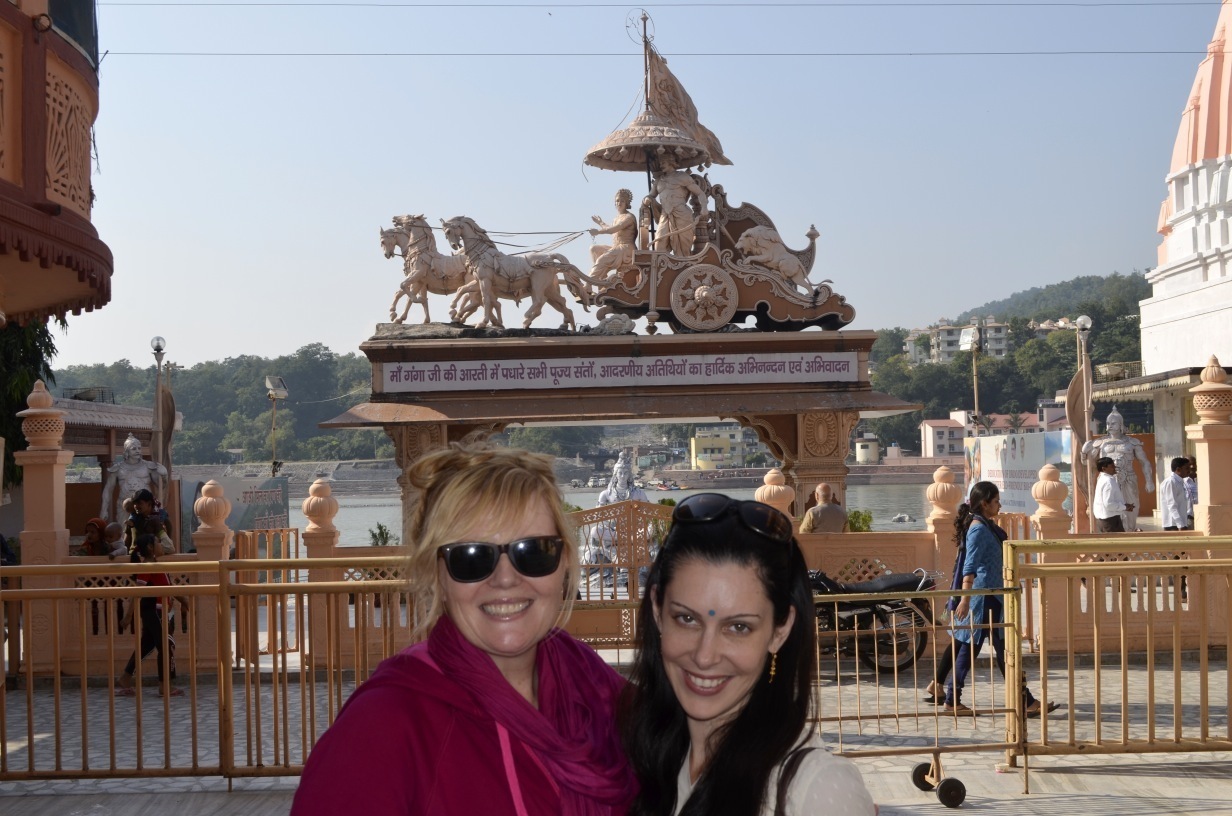
Standing on the banks of the Ganges in Rishikesh. |
|
|
|
 Traveling by longboat! |
 Traveling by bus! |
|
|
|

Traveling by auto-rickshaw! |
 Traveling by push-rickshaw! |
|
|
|

Traveling by train! |
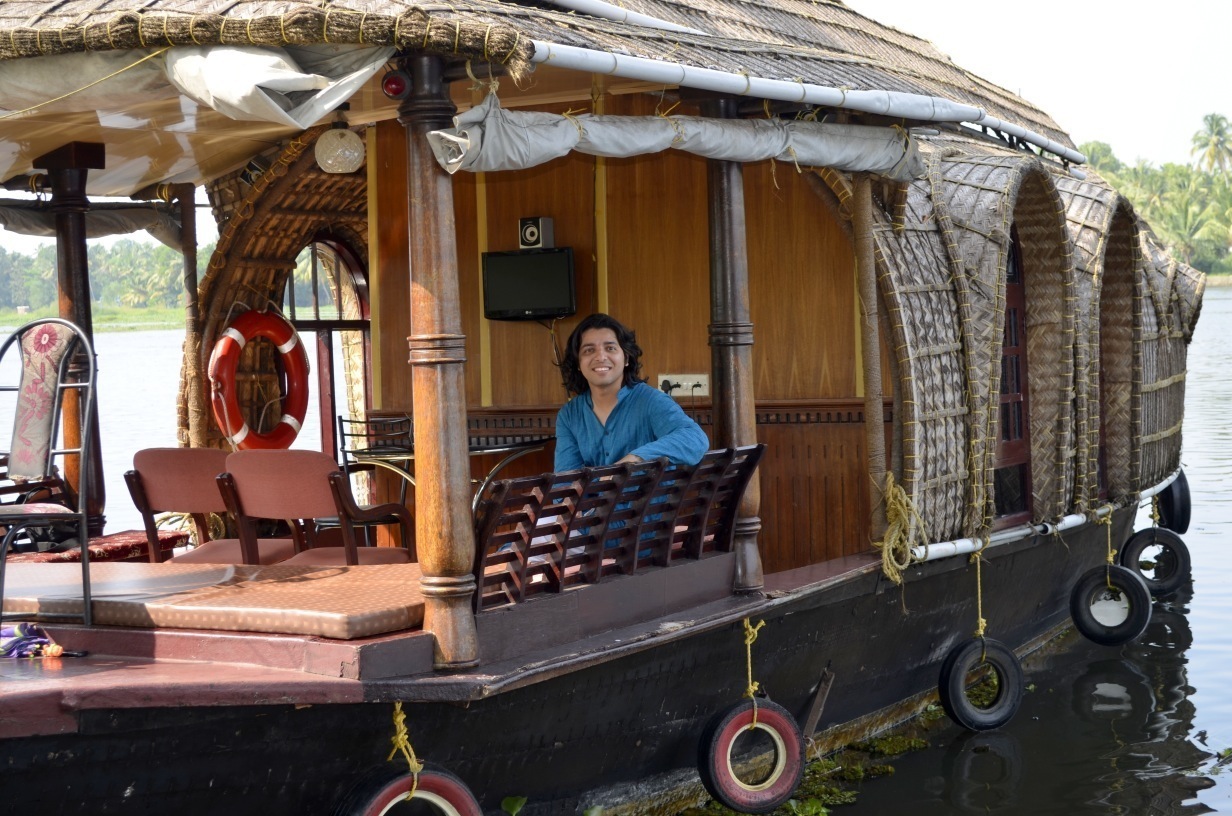 Traveling by houseboat! |
|
|
|

And finally… traveling by elephant!! |

Ganga Aarti, an ancient tradition in which the Ganges is offered flowers, incense, and fire. |
|
|
|
|
Participating in aarti on the Ganges River.
|
 |
|
|
|
|
The tea plantations of Munnar.

|
One foreigner please.
|
|
|
|
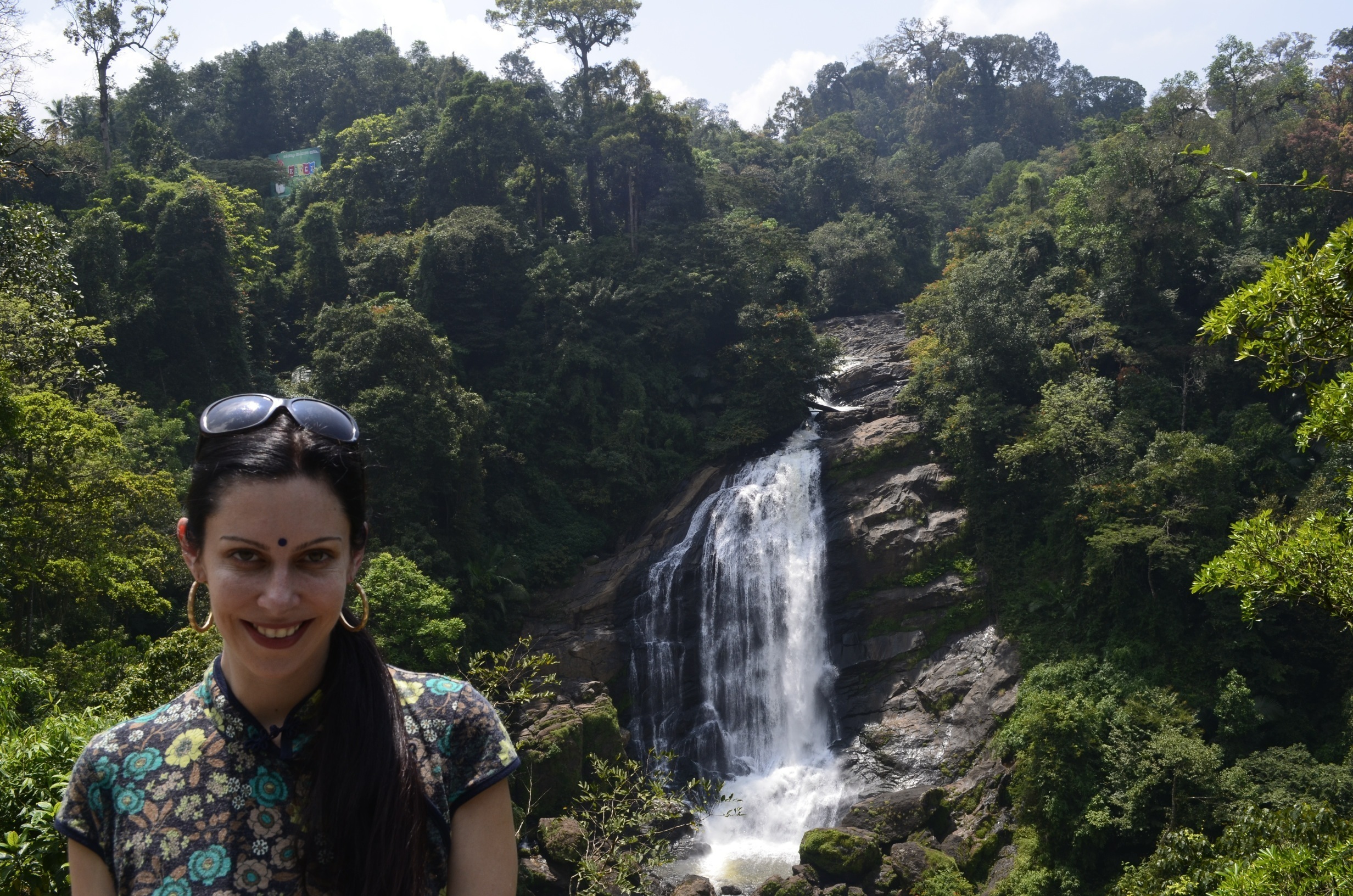
Waterfalls outside of Munnar, in Southern India |
The Hawa Mahal in Jaipur |
|
|

The monkey temple in Jaipur |

The Sas-Bahu temple in Gwalior |
|
|
|

The towering Jain statues of Gwalior |

Jain sculptures of Gwalior |
|
|
|
 |

Coconut juice!

A very popular restaurant called Bikanerwala (featuring lots – AND LOTS) of sweets!

Eating from brass plates and cups!
|

Cotton candy… who knew?!

Gajar Halwa, a traditional dessert made from carrots.

Eating on brass plates and banana leaves!
|
|
|
 |
Since weddings in India can last anywhere from two days to a week (and often the festivities go on for two months if the bride and groom both reside in India), the bride and groom will wear several elaborate outfits during the course of the wedding. For women, the bridal dress is traditionally red, and can be either a sari or a lehenga.

The wedding lehenga was made from red silk and stitched with heavy (very heavy) bead work.
 The wedding sari was yellow silk with silver stitching. The wedding sari was yellow silk with silver stitching.

For the men, a traditional sherwani is worn, usually with a turban and curled shoes called juti.
|

Turban
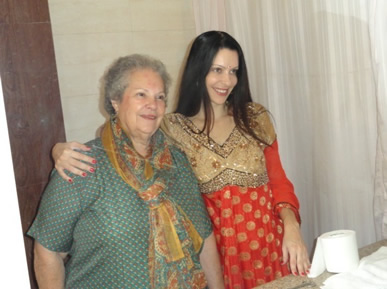
For my first puja (Hindu prayer: see below) I wore a red and gold Anarkali. The name of this outfit is taken from a young woman who lived in the 16th century. She was a beautiful dancer who fell in love with Prince Saleem, but when the Prince told his father about his wish to marry her, his father forbid him from ever seeing Anarkali again.
In response, the prince raised a small army against his father. When his army was crushed, he was given a choice. To surrender Anarkali for execution or to be executed himself. He chose execution. On hearing this, Anarkali gave herself up, asking only one thing: a night with the prince.
During that night, she drugged Prince Saleem and gave herself up to the guards, who took her away and buried her alive.
Although the story cannot be verified, her tomb still stands in Lahore with an inscription written by Prince Saleem that reads, “I would give thanks unto my God unto the day of resurrection.
Ah! Could I behold the face of my beloved once more.”
|
|
|
 |
On her wedding day, a bride in India wears so many jewels she could be mistaken for a walking Ben Bridge advertisement. The jewelry is 22kt gold, and the most commonly used stones are ruby (all of the red stones you see) and emerald (all of the green stones). After the ceremony, it’s either given away or kept in a bank vault to be handed down to the next generation. Here a few of the jewels which made an appearance at my wedding.

Bridal Necklace and Earrings
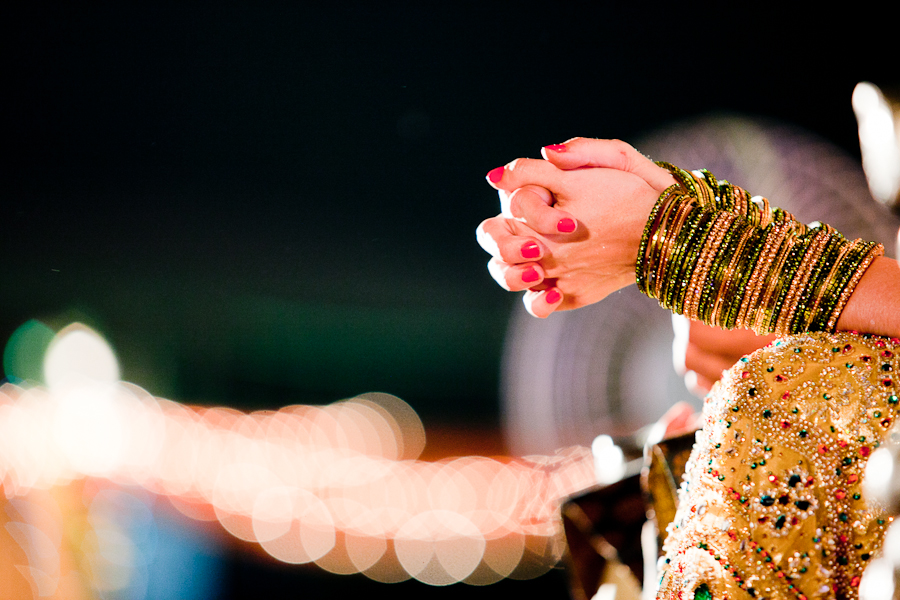
Choori: bangles

The Matha Patti: forehead/hair jewelry

Tikka

Nath: nose ring
|

Vanki: armband 
Earrings 
Rings 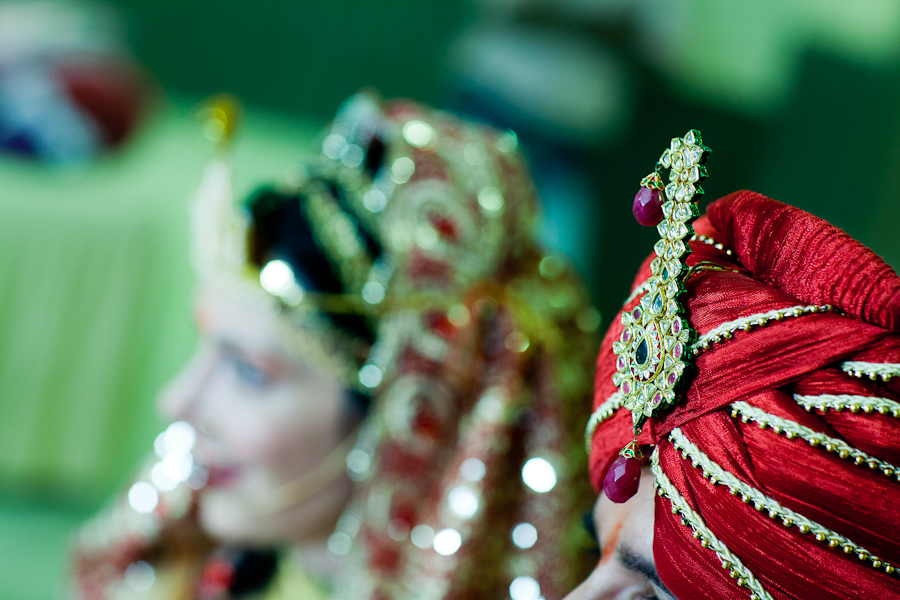
The jewel on the turban is called a kalgi (or sarpech) 
The
wedding rings 
Suhaag Payal: foot bracelet
|
|
|
 |
 |
For those of you who aren’t familiar with mehndi, it’s another word for henna. Decorating a woman’s hands and feet with mehndi (or turmeric paste) dates back to the Vedic times (think 3200 years ago).
Just before the wedding, a bride is given a mehndi party. At my mehndi party, all of the guests who came with me from the US had their hands hennaed!


Once the mehndi dries, it has to be scraped off. Underneath, the color is bright (or in some cases, dark) red.
|
Traditionally in India, a bride would (and often still does) move from her family’s house to the house belonging to her father-in-law and husband. For her life in this different home, her family purchases new clothes, shoes, jewelry, and anything else she might need. These new things would be stored in a single chest called a bridal trousseau (trousseau comes from the French word trousse, or bundle).
 Today, some families in India still put together a trousseau. Here is mine, with gifts from both my mother and my in-laws. I ended up bringing all of it to India (with the exception of the trousseau itself, of course!). After the wedding, it went into my closet, and I stored my wedding lehengas inside. Today, some families in India still put together a trousseau. Here is mine, with gifts from both my mother and my in-laws. I ended up bringing all of it to India (with the exception of the trousseau itself, of course!). After the wedding, it went into my closet, and I stored my wedding lehengas inside.

|
|
|
 |
 |
Colors play an important role in India, but often, their symbolism is opposite from what we’re familiar with in the West. For example, in India, white is the color of mourning, while red is the color of marriage and fertility.
Like most brides in India, my wedding lehenga was red. The lehenga for
my engagement ceremony, however, was gold, and another one was turquoise with silver and crystal embellishments.
Even the bead work is as colorful as it is exquisite.

|
The six signs of a married woman are (arguably in order of importance)
- A toe ring: the most important sign of a married woman
- Sindoor: the red mark a woman places in her hair parting every morning
- The mangalsutra
- The nose ring
- Choori: bangles on the wrist
- Bindi (the red mark on the forehead, although now unmarried women wear it as well)
- An ankle bracelet

|
|
|
 |
| Types of Ceremonies
Weddings are a major occasion in India, and they often go on for days, consisting of dozens of important ceremonies. My husband has been to at least a hundred, and his parents have been to hundreds more (literally). Few things (except perhaps the birth of a child) are so important in their culture.
|
Ceremonial Customs
If you’re not familiar with Indian customs, here are a few that had to be remembered by my guests
-
Shoes are to be left outside of all temples.
-
For anything of importance, you use your right hand! This is because the left hand is used for… um…. toilet business.
|
 |

Before the Engagement happens, a family will often hold a formal puja (or prayer) to bless the upcoming event. |
After the puja, the priest ties a red thread, called a kalava, around everyone’s wrist. You’re supposed to wear it for good luck (and to ward off evil) until it falls off naturally.
|
|
|

During the puja, people give offerings of flowers.
|

Men put sindoor on their wives’ heads after a puja
|

Most Indian weddings feature a stage, where the bride and groom sit to receive visitors throughout the reception.
The stage is always elaborately decorated with rich carpets, flowers, and an ornately carved bench padded with velvet. |

One of the most important elements in any Indian celebration is the food! Because my husband and I are both vegetarian, there wasn’t any meat, but that isn’t a problem in India, where there are dozens and dozens of fantastic veggie dishes to choose from! |

Unlike the West, where a man “pops the question” and gives the bride an engagement ring, marriage is a family affair in India, and the exchanging of rings takes place in front of family and friends during an official ceremony. |

The Engagement Ceremony is an elaborate affair attended by the bride and groom’s closest relatives (which is often more than fifty people). The bride wears a less fancy version of her wedding lehenga, and the ceremony can take place a year or even two days before a marriage. |
|
|
|

During the ceremony, guests come up on stage to give the bride gifts of food, which she places into her chunni (also called a duputta or scarf). |

The tilak ceremony, in which the representative of the bride’s family places red powder on the groom’s forehead. |
|
|
|

During the engagement, the bride and groom feed each other a sweet, symbolizing their intent to care for each other throughout life. |
|
|
|
|
|
|

Barat: Hindu weddings begin with the barat, a procession through the streets in which the groom (often riding a horse) is lead to the bride’s location

The carriage carrying the groom is called a Baghi.
|
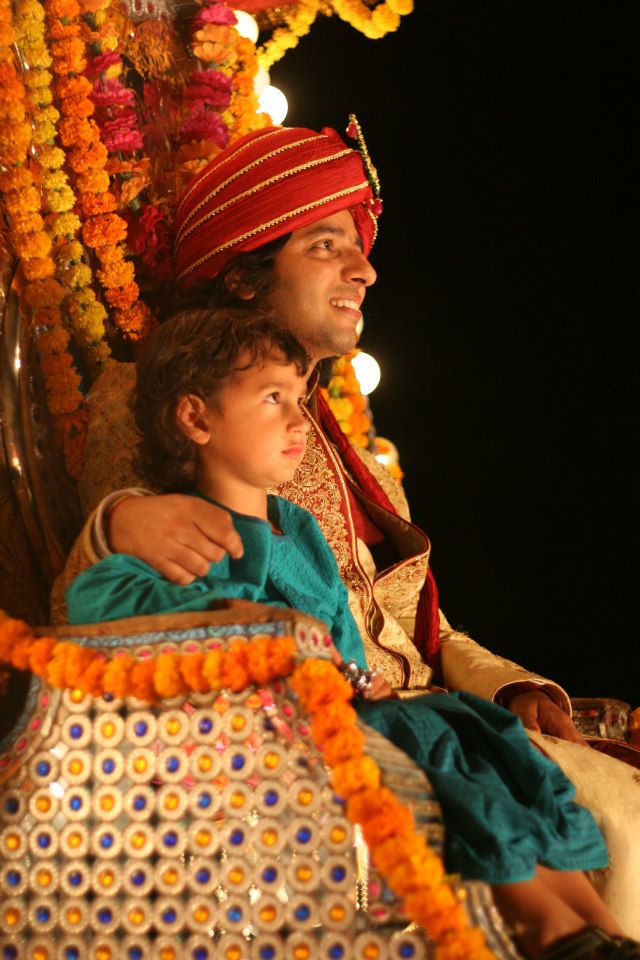
During the barat, the groom is accompanied by a young woman from his household (often his sister or cousin) who shakes a musical instrument in his ear. Historically, this is thought to have been done to distract the groom and keep him from having any second thoughts. Ha! However, this didn’t happen in our wedding. Instead, the groom was accompanied by his second cousin.

Everyone dances during the barat, and there’s lights, music and much laughter!
|
|
|
|
|
|
|
|
|
|
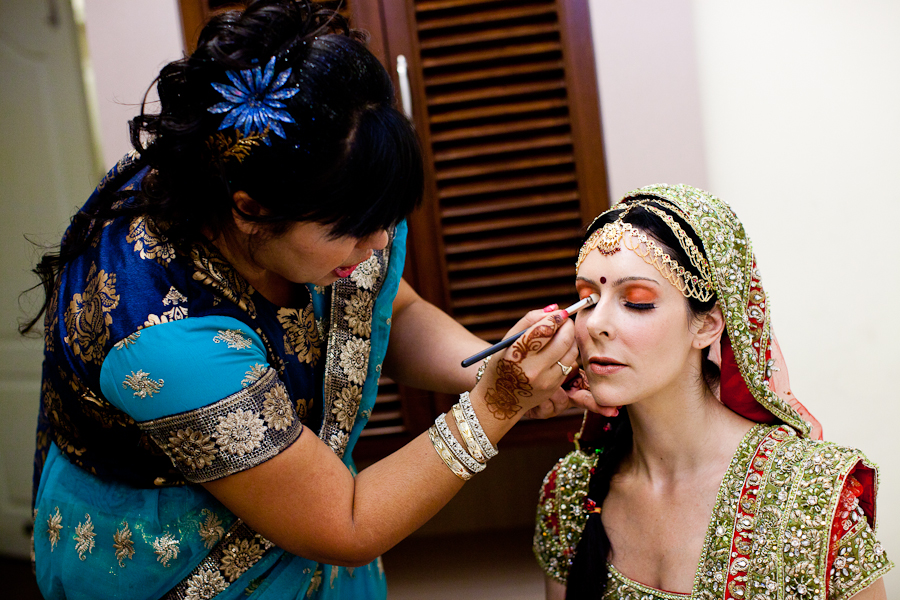
Getting ready for the big night involved two hours at the local salon to put on the dupatta (veil), then makeup. |

All of the women who came from the US wore traditional clothes, either a sari or a salwar kurta. |
|
|
|

This photo shows many of a bride’s traditional jewels. The vanki (armband), the bangles, the nath (nose-ring), the matha-patti (hair/forehead jewels), the earrings, and even – if you look closely – the
bindi, which is the felt dot in the center of my forehead. |
|
|
|
|

Following the barat is the reception! Yes, many times, the wedding reception is held before, not after, the marriage ceremony, and ours was no exception. This is because the religious ceremonies often last until 7am, and few people want to stay that long! |
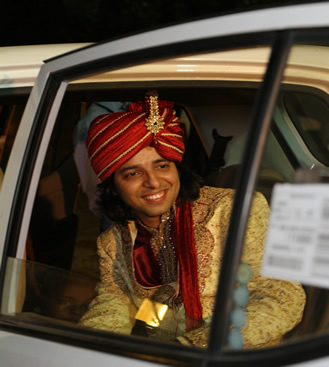
This means the bride and groom are usually awake for 24hrs. When we arrived at the hotel, it was the start of a very long and adventurous night! |
|
|
|
|
|
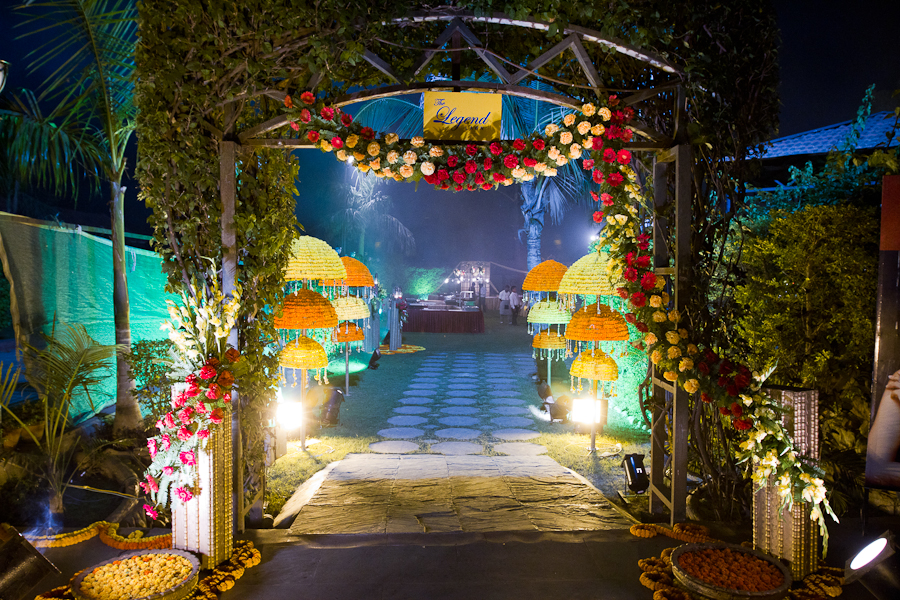

After entering the marriage hall (or lawn in our case), the bride and groom are led to a stage, where they can oversee the festivities and guests can visit them.
|
|
|
|

The official entrance of the groom. |

A puja before ascending the stage. |
|
|
|
|
|

The bride and groom exchange garlands! Historically, this was the moment when the bride and groom were considered married. |
|
|
|

Garlands are made with the flowers that are currently in season, and these garlands included roses and marigolds. Tinsel featured as well! |

One of the traditions in Indian weddings involves making it difficult for the bride to put the garland on the groom. Men behind him will lift him up, sometimes using a chair. |
|
|
|

Success – haha! |


After the reception, the photographer – Arun Arora with StudioRed.In – whisked us away for some more artistic shots.
|
|
|
|
|
|

The religious part of the wedding (the actual wedding ceremony) was held indoors. |
|
|
|
 Pradhaana Homam (The Sacred Fire): Pradhaana Homam (The Sacred Fire): In every Hindu wedding is a fire, representing Agni, the God of Fire.
For this ceremony, the bride changes into a yellow sari and is given a symbolic crown. |
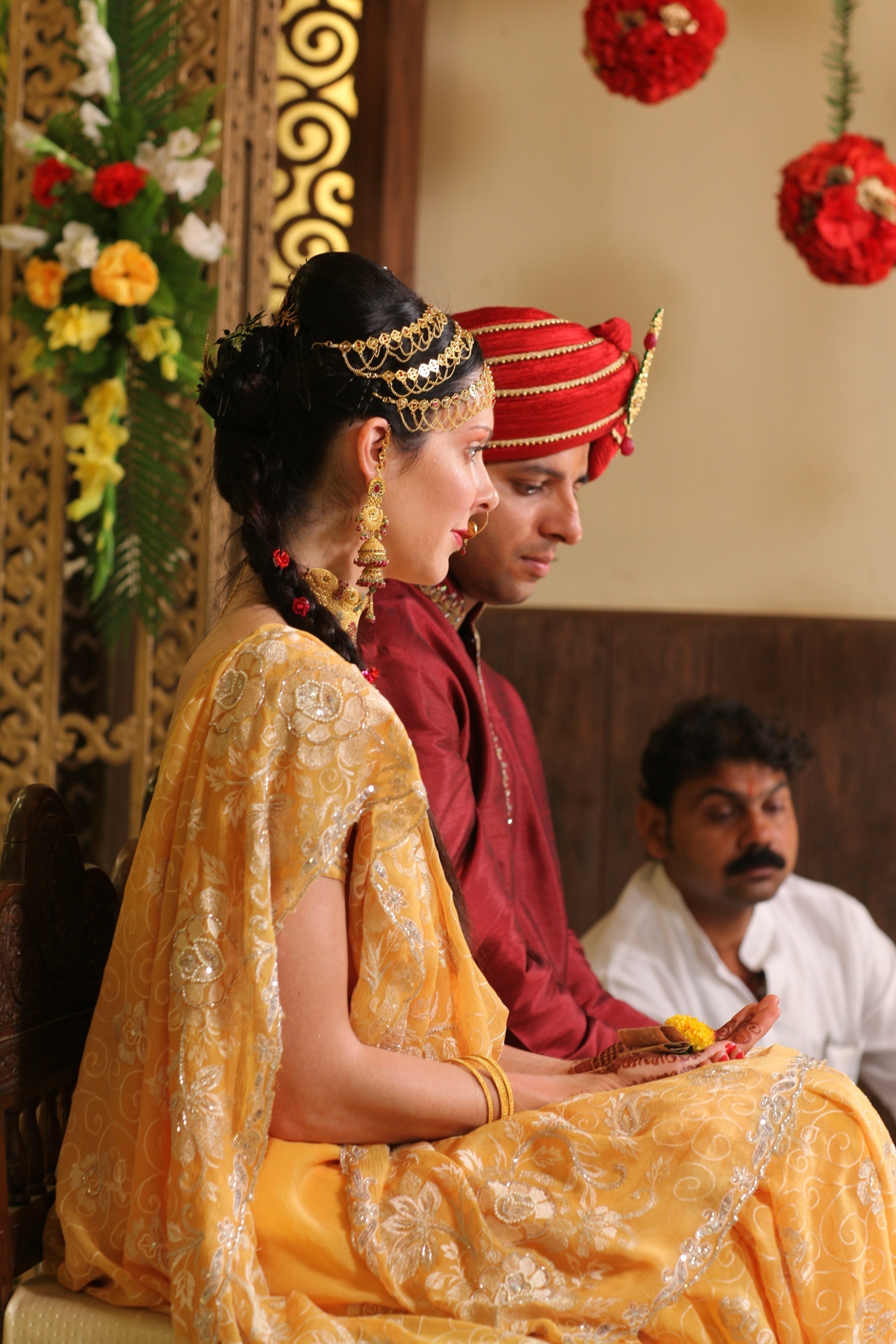 Laaja Homam (Rice Offering to the Sacred Ceremonial Fire):
Laaja Homam (Rice Offering to the Sacred Ceremonial Fire): During this part of the ceremony, the priest sings a hymn to Agni, the God of Fire. While the chanting goes on, the bride and groom offer the fire grains of rice. In return, Agni grants the married couple prosperity and eternal love. |
|
|
|
 Saptapadi (Seven Steps): Saptapadi (Seven Steps): The most exciting part of the wedding. This is where the bride and groom walk seven times around the fire. Each lap symbolizes one life together, so you had better like your spouse! You’ll be together for seven lifetimes (at least!). In between the seven rounds, the priests describes the vows the couple agree to make. For the man, the vows include giving his wife his money to oversee and buying her cosmetics! Not a bad deal… |

One of the most important moments in the wedding ceremony is when the husband’s sister-in-law places a silver ring on the bride’s toe, symbolizing marriage (like the wedding ring in the west). Because India is so large, different states value different symbols as indicators of marital status. But in Uttar Pradesh, where my husband was born, it’s as important as a wedding ring in the West.
|
|
|
|
 Kanyadaan
Kanyadaan: In this ceremony, the mother gives away her daughter to the groom and his family. |

A small jar used for powder. During the ceremony, red powder is used as part of the prayers. |
|
|
|
|
|
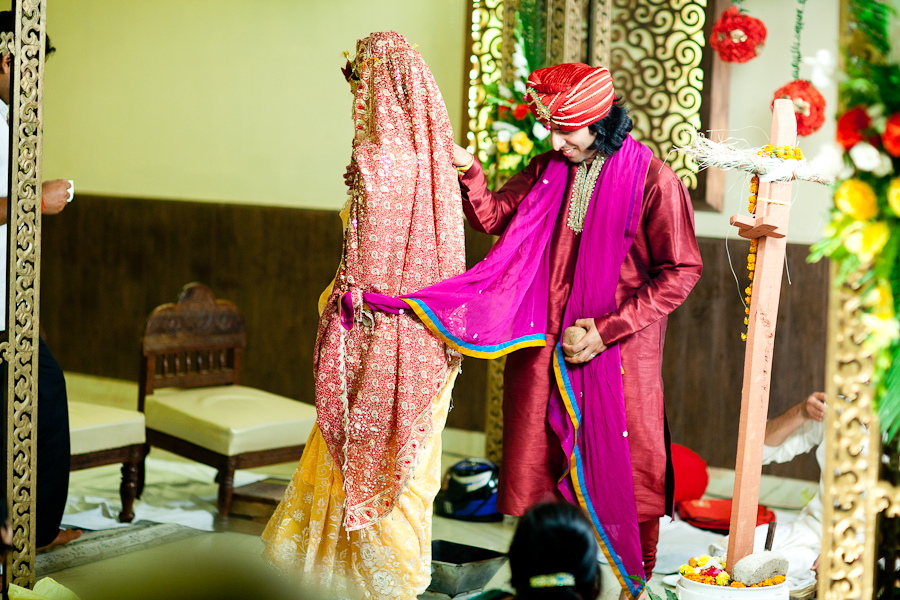
Before taking seven rounds around the fire, the bride and groom tie their clothes together in a symbol of unity. |
|
|
|

At the end of the ceremony, everyone throws flowers. This is the official end! |

The photographers: Our photography team was amazing! They worked so hard, from the time we began dressing for the ceremony at
5pm until well beyond 5am the next morning. |
|
|
|
 Vidai: Vidai: Even today, this vidai is an extremely emotional moment for the bride, since this is when she officially takes leave of her parents and goes to her new city to join her husband in her father-in-law’s house. A palki (palanquin) arrived to carry me away (in our case, to the parking lot – haha!). |
 When I got out, no one was there to bid me farewell. It was 7am and and all of my family had gone to bed – SHEESH!Most brides are taken to their father-in-law’s house, where they will live with their new family. Before entering their new home, however, many other ceremonies take place, meaning the bride is up and participating in social functions for more than 24 hrs! |
|
|
 |
|
|
On the morning after the wedding, several fun ceremonies take place. One includes a bowl of red dye and a ring. The bride and groom sit opposite each other, and the ring is placed in the dye. Whoever finds it first (the best of seven), will be the dominant one in the marriage. HA!
|
|
|
 |
|
|
|
|
|
|